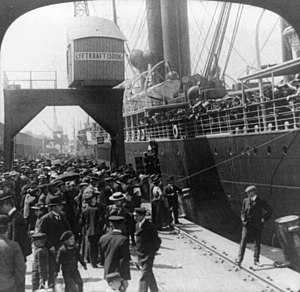Kingston upon Hull sits quietly at the junction of the Rivers Hull and Humber. Due to its ideal location, the port has long enjoyed a successful and lively trade with most of Northern Europe. Shipping lines not only brought significant financial revenue to the town, but also added greatly to the culture and community as migrants made their way through the port.
Prior to 1836, however, migrants flowed in at a mere trickle. Those who passed through were primarily there for commercial reasons. Some migrant ships did pass through Hull on their way to Canada or the US, though these were infrequent and the numbers negligible. The few ships that did accommodate migrants were unpleasant and the journey was a tiresome ordeal. Accommodations were cramped and voyage timings were irregular.
All of this changed in the 1840s as steamship companies in Hull, Leith, Hamburg and Gothenburg began offering regular emigrant services via the UK. The steamships dramatically shortened the time it took to travel between mainland Europe and the UK ports, and thanks to contracts with the Royal Mail postal service, steamship companies were able to offer trips all throughout the year (rather than being limited to the previously established “immigrant season”).
The Wilson Line of Hull began running steamship services from Norway and Sweden as early as 1843. The North Europe Steam Navigation Company followed in 1853, running a strong fleet of nine steamers back and forth on the Christiania and Gothenburg route. By 1858, however, the Wilson Line practically monopolized the route from Scandinavia to Hull, and brought the majority of emigrant traffic.
From the port cities, the transmigrants were taken by train to Southampton, Liverpool, Glasgow, or London. In these larger cities, the migrants boarded large transatlantic liners for the final leg of their journey to the United States. Passengers could purchase a complete travel package that covered the entire trip including the steamship to Hull, the train ticket on the Transpennine Railway Line to Liverpool, and the final ocean liner ticket that would take them to their final destination.
This brought on a boom of transmigration as folks travelled en masse from Sweden and other Northern European countries. Of course, the city of Hull was not initially prepared for such an enormous number of emigrants, thus emigrant houses and railway stations quickly became overcrowded and a serious health risk. After a cholera outbreak in 1866, the city put major preventative measures in place. Travellers were no longer allowed to roam the city on foot, but were required to remain on board the steamers until their trains were ready to depart.
In 1871, the Northeastern Railway Company built a waiting room near Paragon Railway station so that the emigrants could relax, meet ticket agents, use the washrooms and facilities and be sheltered from the wind and weather. Eventually, the majority of the emigrants were passing through the Paragon Railway Station. Though the travellers were only there for a short time, their numbers were so great that in 1881, the station doubled the size of its waiting room. Women and children were able to wait in a separate room, and sanitary facilities were expanded and improved to meet the greater demand.
At times, so many emigrants were arriving that up to 17 carriages would be hooked up to a single steam engine. Passengers would cram into the forward carriages, while their baggage was piled high in the rear four cabs. Trains pulled out of Hull every Monday morning to make the three to four hour trip to Liverpool.
By 1914, however, transmigration had slowed to a crawl once more. The UK’s Alien Immigration Act of 1905 had severely restricted travel, and when WWI broke out followed by the passing of immigration acts in America, mass transmigration came to an end. Over those 70-odd years, however, 5 million transmigrants flowed through the UK, with approximately 60% of them passing through the port in Hull.
Related Items
Sources
1. The research of Dr Nicholas J. Evans at the University of Hull. For further information please access the following article he has written Indirect Passage from Europe. European Transmigration via the UK, 1836-1914, Journal for Maritime Research, Volume 3, No 1 (2001), pp. 70-84

